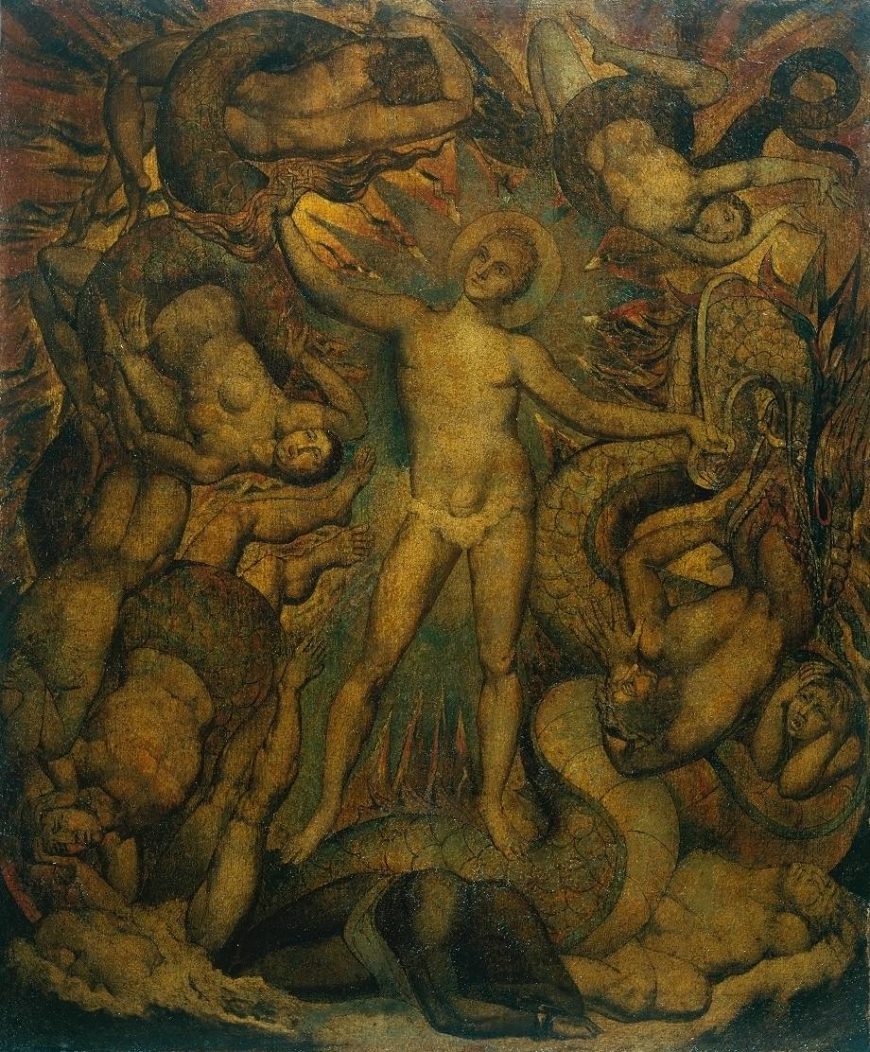
William Blake, The spiritual form of Nelson guiding Leviathan, in whose wreathings are infolded the Nations of the Earth, c. 1805–9, tempera on canvas 30″ x 24″ / 76.2 x 62.5 cm (Tate Britain, London)
William Blake occupies a unique position in art history in that he was both a major artist and a major poet. Often the two went hand-in-hand, his art illustrating his poetry, or if not his, the poetry of others. I suppose, then, for me, what makes this such an intriguing example of his work is the fact that here, unusually for Blake, the subject is not drawn from any literary source, but from contemporary history.
The spiritual form of Nelson guiding Leviathan was first shown in his solo exhibition of 1809, held at his brother’s house in London’s Soho; a site, incidentally, that also served as the family shop, selling women’s stockings. The reviews were mostly negative, one famously describing the paintings as “the wild effusions of a distempered brain.” Not everyone hated it, though, and some of the paintings did sell, including this portrait of Admiral Nelson.
Admiral Nelson
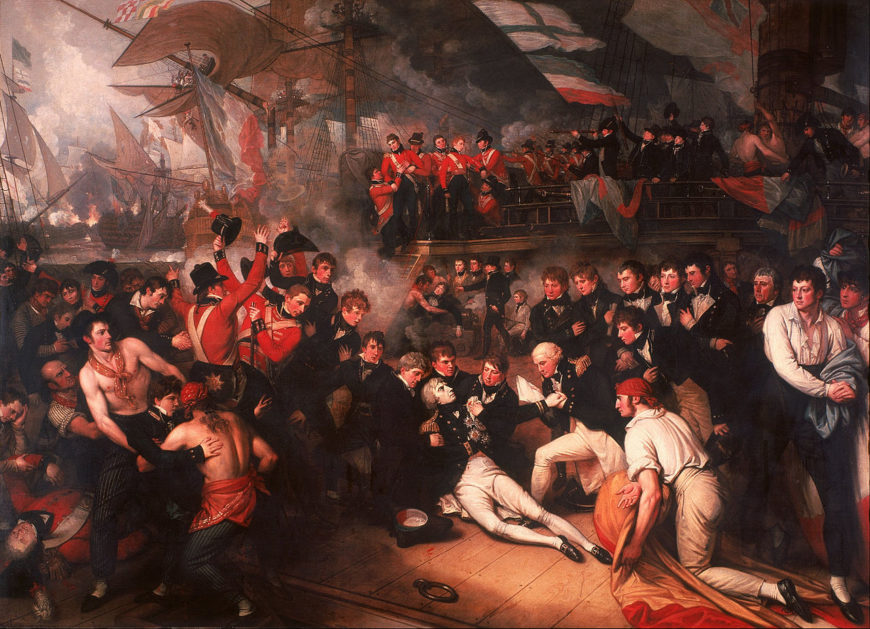
Benjamin West, The Death of Nelson, 1806, oil on canvas, 71.9″ × 97.4″ (182.5 × 247.5 cm (Walker Art Gallery, Liverpool)
Nelson was the hero of one of the greatest events of this period, the Battle of Trafalgar in 1805. You might know him as the figure atop the column in Trafalgar Square. At the Battle of Trafalgar, Nelson led a great victory over Napoleon’s navy, but was fatally wounded. The outpourings of patriotic feeling that followed these events and the artistic opportunities they offered, were quickly exploited by many artists.
Blake’s Nelson, however, is a world away from those melodramatic scenes of the dying hero that were so current at the time like the above example by Benjamin West.
A spiritual likeness?
Instead of a lifelike portrait, Blake paints Nelson’s “Spiritual” likeness. He stands on top of the Biblical sea creature, Leviathan, whose body encircles him. Nelson controls the beast with a bridle, attached to its neck, which he holds loosely in his left hand. Trapped in, crushed under, or in one case, half-consumed within Leviathan’s coiled body, ten figures, male and female, are arranged around the figure of Nelson; these represent the European nations defeated by the British during the Napoleonic Wars. Under his feet is a black body, whose wrists are fettered. The head and arms of the figure to the bottom left appear to be submerged under water, which occupies the lowest portion of the painting. Nelson stands in the center of a graphic explosion of color, creating a corona of light around him.
West, Immortality of Nelson
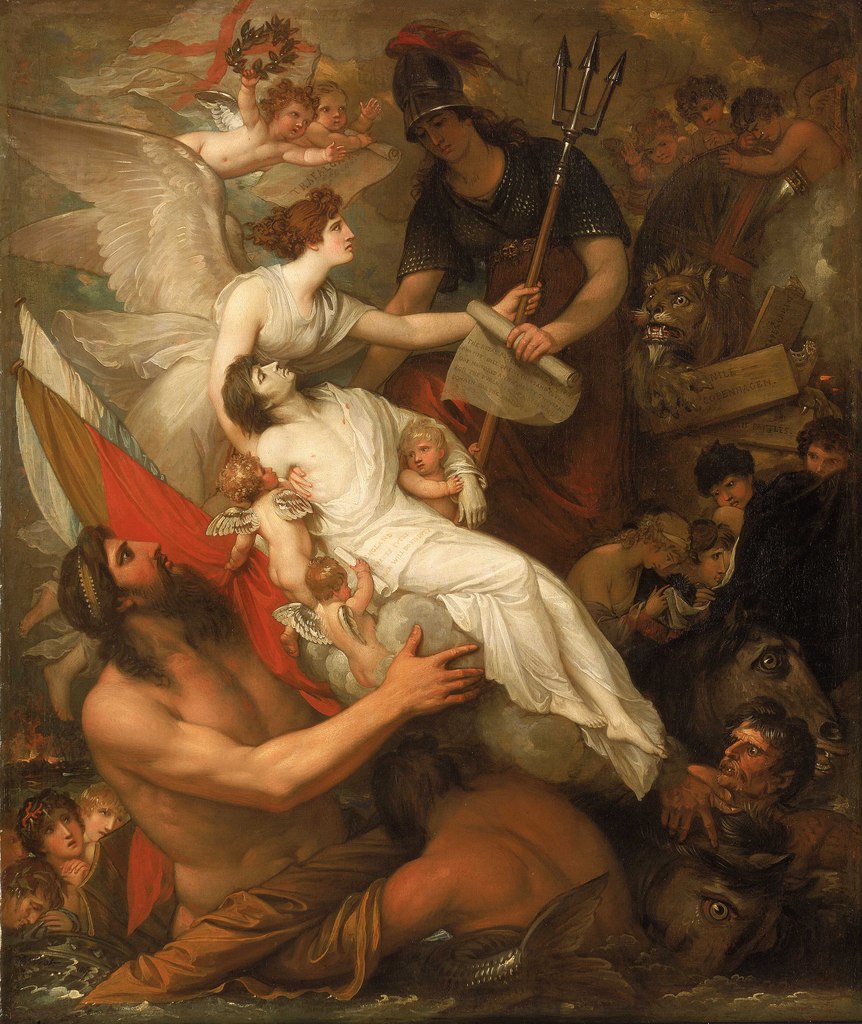
Benjamin West, The Immortality of Nelson, 1807, oil on canvas, 90.8 x 76.2 cm (National Maritime Museum, Greenwich)
The visual coupling of explosion and water may bring to mind naval conflicts, but clearly this is no illusionistic representation of any specific battle. The painting should rather be viewed as an allegory, a representation of an abstract idea in material form.
Benjamin West’s The Immortality of Nelson of 1807 is similarly allegorical. Here Neptune delivers the soul of Nelson into the arms of Brittania (an allegorical figure of Great Britain). West draws on Christian art in the composition, recalling Rubens’ Descent from the Cross.
Classical, Biblical and Hindu References
Like West, Blake also uses classical and Christian references: the nude Nelson in contrapposto is modeled on the Apollo Belvedere, for instance. Similarly, Nelson is shown with Christ-like attributes: the halo and the loincloth. What distinguishes Blake’s image is the unusual composition that critics have noted owes more to Indian than Graeco-Roman or Christian art, specifically statues of Nataraja (the Dancing Shiva, the Hindu god of destruction, who dances within an aureole of fire, standing on Apasmara, the Dwarf of Ignorance, who is killed during the dance).
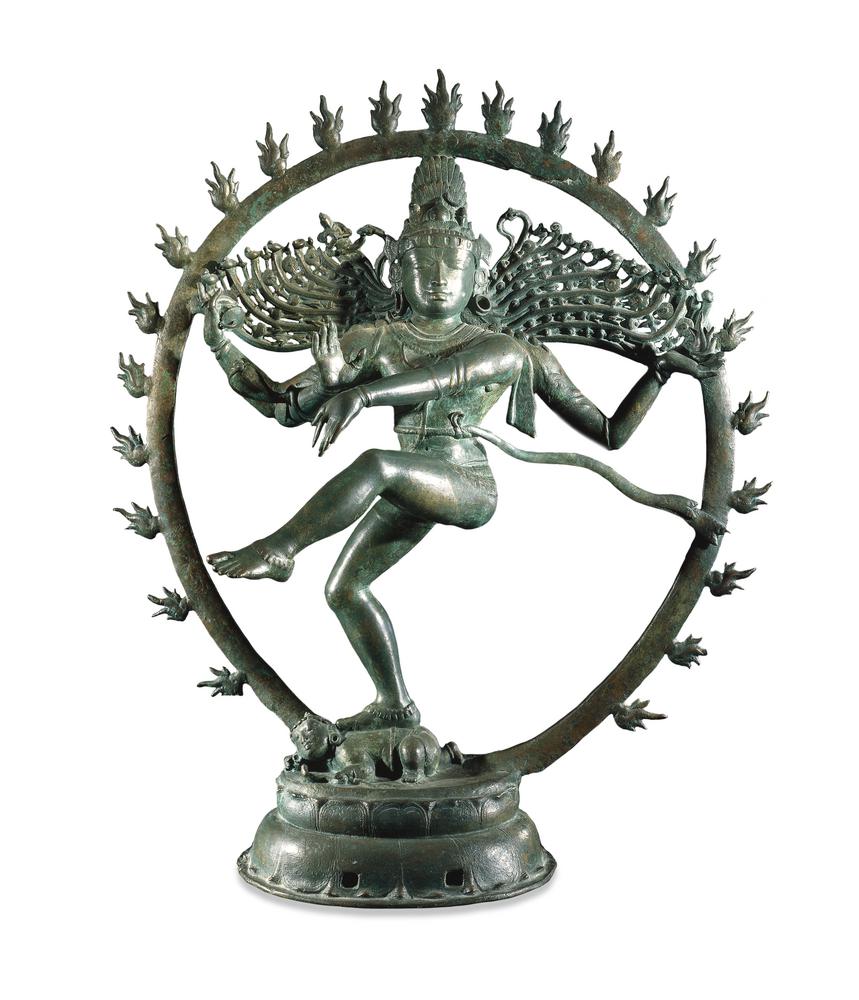
Bronze figure of Nataraja, from Tamil Nadu, Southern India, around AD 1100,89.5 cm high (© The Trustees of the British Museum)
Blake highlights this connection in the Descriptive Catalog he wrote for the exhibition. Here, he claims to have been “taken in vision” and shown works of art from “Persian, Hindoo, and Egyptian Antiquity…some of them one hundred feet in height.” Drawing on these visionary works he wished to create similarly grand images of national heroes. Though modestly proportioned, Blake hoped this preparatory work would gain him a commission to create a massive fresco. It was for this reason he painted using tempera, only on canvas rather than plaster, which sadly accounts for the sorry state of the painting.
For all his talk of visions, though, Blake would have seen Hindu art in his waking hours, too, as Britain’s growing colonial presence in India meant that translations of Hindu scriptures and engravings of its artworks were in wide circulation. Among educated circles these works were discussed with avid interest, many holding the view that in India could be found the source for all the world religions. Blake draws on these ideas in the painting, which is exceptionally eclectic in its scriptural references. Leviathan comes from the Old Testament, and like Shiva, is said to represent the forces of destruction in the world. It is difficult to know what Blake is implying here though, for while Shiva destroys in order to transform and so is seen as a positive force, in Christian tradition at least, Leviathan is generally held to be an agent of Satan.
Certainly, there is something confusing, if not downright disconcerting, in this alliance of a national hero with a diabolical monster. Similarly, the contorted figures and agonized expressions of the defeated nations contrasts uncomfortably with the calm, classical elegance of Nelson; while compositionally, the claustrophobic treatment of the space lends the painting a nightmarish quality giving one the distinct impression that this is more a critique than a celebration of Britain’s naval supremacy, a view supported in the fact that Blake himself was a pacifist.
An anti-slavery message?
Blake was also a fierce opponent of slavery. The black body in the painting may act as a reference to the Slave Trade Act of 1807, which abolished the trade of slaves in the British Empire. This figure is situated, much as Apasmara the dwarf is to the Dancing Shiva, directly beneath Nelson’s feet. It could be argued that, just as the one stands for ignorance, the figure here represents not an individual slave as such, but slavery itself, which is in the process of being destroyed.
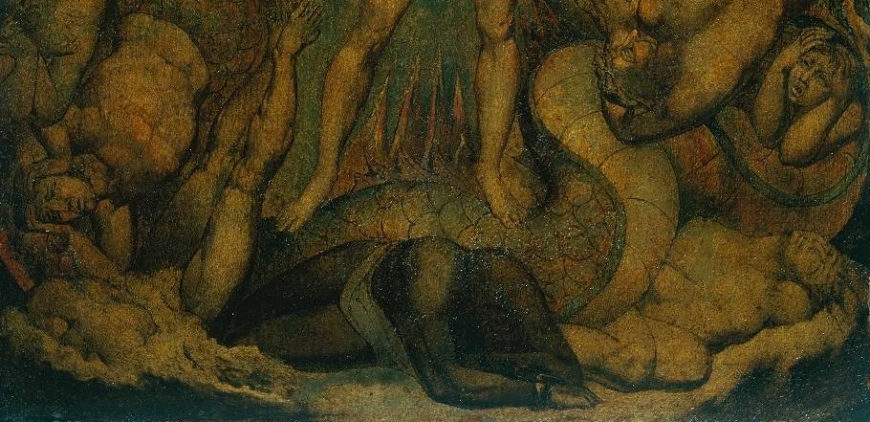
Black figure at Nelson’s feet (detail), William Blake, The spiritual form of Nelson guiding Leviathan, in whose wreathings are infolded the Nations of the Earth, c. 1805–9, tempera on canvas 30″ x 24″ / 76.2 x 62.5cm (Tate Britain, London)
Whatever Blake’s intentions may have been in depicting the figure thus, we are struck most by his individual suffering, prostrate and wretched, if anything he serves to remind us that though the trade had been criminalized, slavery itself would continue to be legal for many years to come.
Wildly ambitious and devilishly ambiguous, The Spiritual Form of Nelson guiding Leviathan is a work that for all its oddities and contradictions speaks directly to us in our postcolonial age. Undoubtedly the British Imperial project, made possible by its naval strength, enriched Britain financially through the appropriation of immense natural resources, as well as culturally through the influx of new ideas and new artistic languages. The question remains though as to what rights and responsibilities metropolitan artists, like Blake, have when adopting the intellectual, cultural and artistic resources of other, less dominant, cultures.
Additional resources
William Blake: Fusing the Classical Figure, Mythology, and Religion on ArtUK
This painting at the Tate Britain
William Blake, the artist (Metropolitan Museum of Art’s Heilbrunn Timeline of Art History)
Benjamin West, Death of Nelson at the Walker Art Gallery, Liverpool
Benjamin West, The Immortality of Nelson at the National Maritime Museum
Nelson: The Hero and the Man (BBC site)
Bronze Figure of Nataraja at the British Museum

